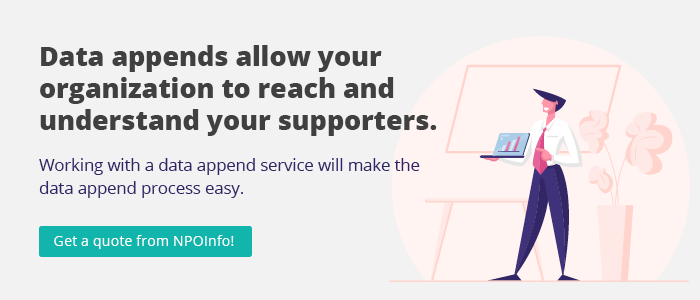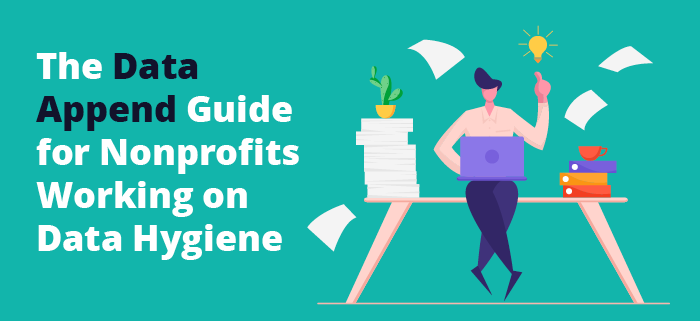The Data Append Guide for Nonprofits Working on Data Hygiene
Whether they consciously think about it or not, nonprofits collect data every day. From accepting donations to receiving new email newsletter sign-ups, every time a nonprofit interacts with its supporters, it’s absorbing different data points.
These days, all types of organizations understand that data should guide decision-making because it acts as clear evidence for trends and occurrences within your industry or operations. Nonprofits should be no different. Using data effectively can help your organization optimize its content and spread its mission even further.
The only problem with this data-driven approach is that if your organization has incorrect or incomplete data, then it can be difficult to comfortably rely on that data. That’s where data appends come in.
Data appends fill in the gaps in your data so that you can make well-informed decisions and communicate with a larger breadth of your supporters. If your organization isn’t familiar with data appends, then we’re here to help you learn the basics and how you can get started with the data append process.
Take a look at the questions we’ll answer in this guide:
- What Is a Data Append?
- What Types of Data Appends Are There?
- What Is a Data Append Service?
- What Value Do Data Append Services Add?
- What Is the Data Append Process?
- How Do I Select a Data Append Service to Work With?
Here at NXUnite, we connect nonprofits with the tools they need to be successful. We believe that data appends are an essential part of good data hygiene, which all nonprofits should practice in order to improve relationships with supporters and grow their organizations. Learning about what data appends are and how they work is the first step in improving your organization’s data hygiene, so you’ve come to the right place!
Equipped with data appends, your organization will not only improve its data hygiene but will also gain better insights into who your supporters are and how you can best reach out to them. But first, let’s learn what data appends are and how a data append service can help you with the process.


What Is a Data Append?
A data append is a piece of new information added to your nonprofit’s database. During the data appending process, data append services pull data from external sources to correct incorrect data or supplement incomplete data. They use any supporter information that you supply them with, such as contact information, to correctly identify the right individuals across different sources.
Data appends are important because they ensure your database is more complete with the information you need. For example, you could be missing an email address for an important donor. Without their email address, you won’t be able to thank that donor for their contributions or update them about your organization, potentially jeopardizing your relationship with them.
3 Different Approaches to Data Appending
While all data appends refer to adding new information to a database, there are different ways to go about the process and obtain the data you need. These are the three different approaches to data appending:
- Forward: Forward appending is what most people think of when discussing data appends. It occurs when an append adds to basic information your organization already has. For example, you may have a donor’s name and mailing address, but a data append could add their phone number as well.
- Reverse: As the name implies, reverse appending is the opposite of forward appending. With this approach, your organization uses a singular piece of data to fill in the related basic information. You might have email addresses from your newsletter subscribers, but you could use reverse appending to fill in their names.
- Fractional: For a combination of the previous two approaches, use fractional data appending. In this case, you could use a supporter’s name and email address to find their mailing address. Fractional appending puts the best of both approaches together to find the information you need.
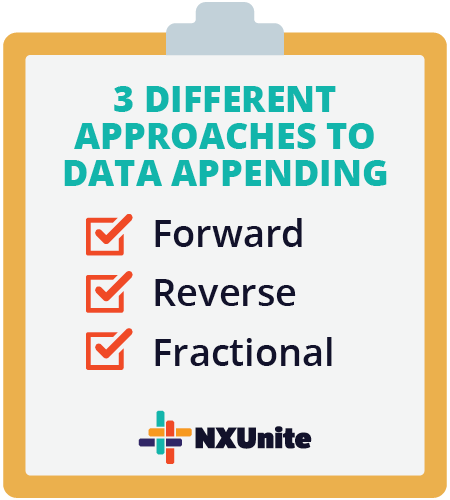
To determine which data append approach to take, think about which type of data you’re looking for. As we mentioned, forward appending is most typical and the most beneficial for nonprofits, so it’s never a bad idea to start there.
Data Append Timing
In addition to the different approaches to data appending, there are also two different categories of data appends based on the timing of when you’ll receive them:
- Batch: Just as it sounds, batch appending is when organizations send a batch of information to be appended. This approach is best for nonprofits with large databases that have a clear need for organization. For example, you might be missing some of your volunteers’ phone numbers and mailing addresses. To fix this, you can send a file with the data you have to a data append service, and they will add the missing information all at once.
- Real-time: For automatic updates to individual records, use real-time appending. Once you send in your information, a server will update it in real-time when needed. An example of a situation where you could use real-time appending is if you want to analyze your newsletter sign-ups and fill in contact information that subscribers left out.
Again, the choice between batch and real-time appending should depend on your organization’s needs. For most types of data appends, batch appending is more beneficial because it allows you to get all the information you need at once. However, real-time appending can be useful for ongoing data append-based solutions.

What Types of Data Appends Are There?
There’s a wide variety of data types you can append to your nonprofit’s database. Depending on your marketing goals and the information you have missing, you can choose the data appends that best fit your organization’s needs.
If you’re not sure which types of data would benefit your nonprofit, we’ll walk through the four different categories to give you a better idea of what your organization might need.
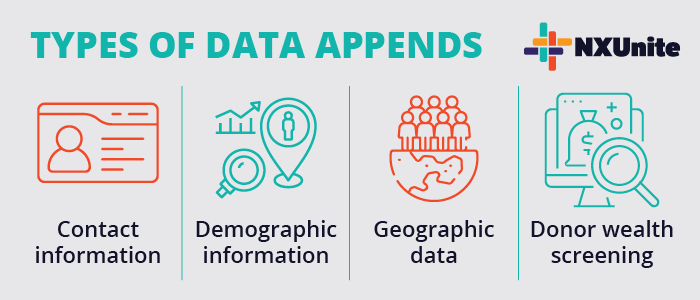
1. Contact Information
A lot of the data we’ve talked about so far falls under the umbrella of contact information, including phone numbers and email addresses. Believe it or not, social media profiles are also a type of data append in this category.
Communication with your supporters is essential to keeping your nonprofit running smoothly. Make sure your contact information is complete, up to date, and accurate with contact information appends. It’s important to review and update this type of data regularly since supporters’ contact information can change frequently for a variety of reasons.
2. Demographic Information
Demographic information allows you to learn a little more about who your supporters are. Types of demographic information you might collect include:
- Age
- Gender
- Race and ethnicity
- Income
- Employment
- Level of education
- Marital status
Although the benefits of having supporters’ demographic may not be as clear as those for contact information, knowing more about your supporters can help you reach them more effectively.
For example, date of birth appends allow you to know each supporter’s age so that you can segment them based on how old they are. Younger donors may respond better to text message outreach and social media campaigns while older donors may prefer direct mail. Additionally, knowing your supporters’ dates of birth presents the opportunity to offer birthday gifts or perks.
3. Geographic Data
Using geographic data appends can assist you in creating location-based campaigns. Segmentation based on location can be useful if your organization only operates in a certain area, if there are different localized branches of your nonprofit, or if you’re hosting in-person opportunities in certain areas.
The main geographic data append type is mailing address appends. Having the addresses of your supporters can allow you to send them direct mail and notify them of local opportunities.
4. Donor Wealth Screening
Donors are the primary source of your fundraising, so it can be helpful to know a little more about their assets. That way, you can predict how much and how likely they are to donate. It’s important to focus your marketing efforts on donors who seem to be open to upping or continuing their support at the moment. Doing so can help you prevent wasting time and energy on donors who may not currently be interested in lending their support.
Here are examples of donor wealth data you could append to your donor database.
- Net worth
- Likeliness to give
- Prior donations to other nonprofits
- Business and foundation affiliations
- Real estate
- Stock holdings
Data append services use donation and wealth databases to find this information based on the donor data you supply them with. Once you receive your donor wealth appends, you can customize your outreach to each donor based on their ability and propensity to give.

What Is a Data Append Service?
Since data appending can be rather difficult and time-consuming when done by someone who’s inexperienced, it’s best to turn to the experts. A data append service can help you obtain all different types of data appends. They work to fill in the gaps in your database to help you understand and reach your target audience better.
Data append services are reputable sources for help with your data hygiene. They can append any type of data you need. Additionally, efficient data append service providers will talk to your organization about your current data needs and concerns in order to help you figure out your next steps along your data journey.
You may still not be convinced that partnering with a data append service could be helpful for your organization. If that’s the case, we’ll explain the exact value data append services bring to the table for nonprofits in the next section.

What Value Do Data Append Services Add?
As a nonprofit professional, you must be incredibly careful to budget your funds and resources effectively. Data hygiene is important because it can save your organization time and money by making sure you’re reaching out to the right people.
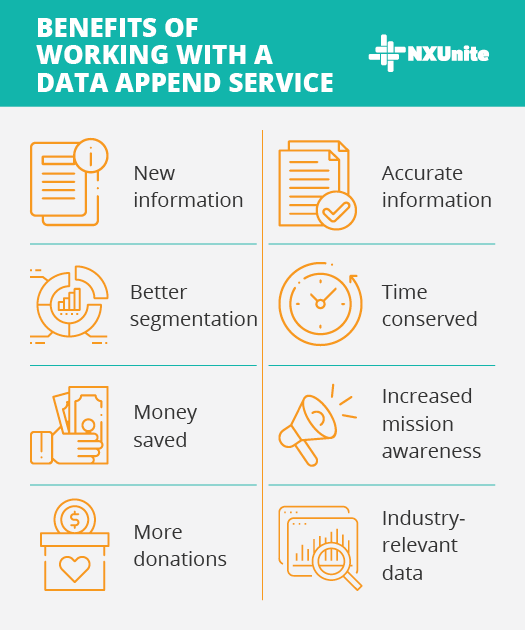
Basic Benefits of Data Appends
Leveraging data append services is a smart investment for nonprofits because they can help you reach your target audience more efficiently. You’ll be able to make more data-driven decisions and have the right contact information for your supporters.
Now that you know the basic premise of what data append services do, let’s explore the benefits they can provide to your organization:
- New information. Data append services provide you with information you didn’t previously have access to. Whether that’s phone numbers, dates of birth, or mailing addresses, the right data append services can find the information you need.
- Accurate information. You may be missing information in your database, but you may also have incorrect or outdated information that needs to be updated. Data append services check the data you already have and replace outdated data with the most current information.
- Better segmentation. The more you know about your supporters, the better you can group them based on qualities relevant to your campaigns. Segmentation is a great way to customize each supporter’s experience and help them build a deeper connection to your organization.
- Time conserved. With access to the right resources, your nonprofit probably could find append data on its own. However, that would be very time-consuming for your team. Leave it to the experts who offer professional data append services, know what they’re doing, and can help save time that you can reallocate to other projects.
- Money saved. The investment of working with a data append service is nothing compared to the money you’ll lose on behalf of bad data. Data append services can help correct errors in your database to lower your marketing costs.
Beyond rounding out your supporter database, data appends add value to your organization in several different ways.
Nonprofit-Specific Benefits of Data Appends
While the above benefits apply to any organization, there are specific benefits for nonprofits that data append services provide, such as:
- Increased mission awareness. At the heart of your organization is its mission. Once you have the data you need to communicate with your supporters effectively, more people will become aware of your nonprofit’s cause.
- More donations. Now that you’re reaching out to the right audience, you’re bound to see more funds flood in for your cause. Especially if you’re able to leverage donor wealth appends, you’ll be able to improve your fundraising efforts tremendously.
- Industry-relevant data. Of course, all organizations could benefit from knowing their supporters’ names and email addresses, but there are certain data points that are especially useful for nonprofits. For example, if you know a donor’s employer, you can discover whether that employer participates in matching gifts and use that knowledge as an incentive for donors to contribute. Data append services geared toward nonprofits like NPOInfo are helpful resources for identifying opportunities to use data more effectively for your nonprofit.
If you’re looking to understand your supporters better, hiring a data append service provider is the right choice. While your organization won’t have to do much besides supplying them with the data you already have, it’s helpful to know how the data append process works so you can ask them any questions you may have.

What Is the Data Append Process?
We’ve talked a lot about the fact that data append services take the information you already have about your supporters and use it to find the data you’re looking for. How exactly does that process work though?
There are several steps that data append services follow in order to deliver data appends to their clients. Here are those steps:
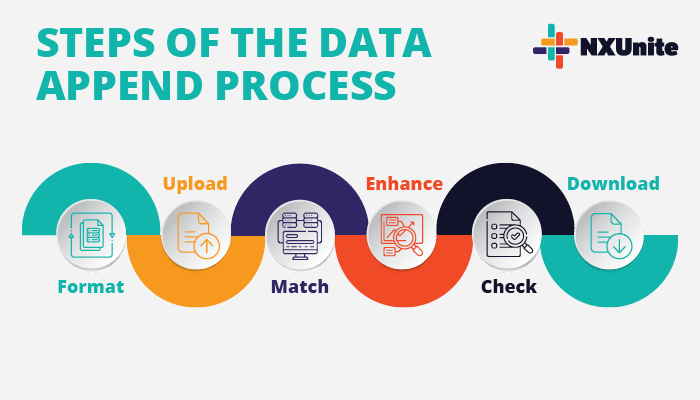
- Format the data. Before sending over your supporter data, make sure it’s all in the same format. Data append services typically prefer a comma-separated value (CSV) format for the data.
- Upload the data. Next, compile all of the data into one file and send it to your data append service of choice.
- Match the data. Once they receive your supporter data, the data append service will compare it to the databases they have in order to identify which information is missing or inaccurate.
- Complete the appends. In this step, data append services enhance the data you’ve provided by adding the information they’ve found.
- Check the data for accuracy. Before sending the appended information back to you, most data append services will check to make sure the data they’ve found is accurate. They may have manual or automated methods of verifying the data.
- Send the data to the client. Lastly, the data append service will send the client the data file for them to download. While data append services like to work with CSV values, they can convert the file into virtually any format that the client prefers before sending it back to them.
The process is easy to follow, and once your organization formats and uploads the data, it’s all up to your data append service to put in the work. Since they’re experts in this area, they typically complete the process fairly quickly, allowing you to leverage your new data right away.
Now that you understand the data append process and how helpful a data append service can be, it’s time to find the data append service you’d like to work with.

How Do I Select a Data Append Service to Work With?
There are so many data append services out there that are ready to help your organization with its data needs. However, it’s important to do thorough research when finding a data append service provider to ensure that they have the qualities you’re looking for.
If you don’t know where to start, we’ve compiled a list of characteristics that we believe all data append services working with nonprofits should have, including:
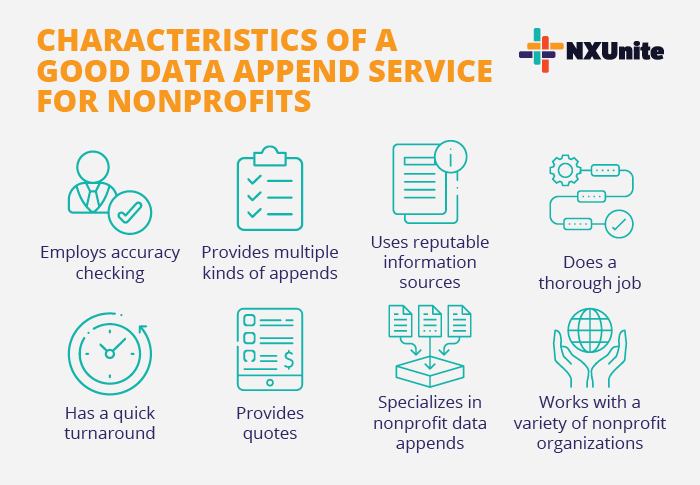
- Employs accuracy checking. It would be a waste of your time and funds to go through the data append process and receive incorrect or outdated data. Look for a data append service that has accuracy checks or scans in place.
- Provides multiple kinds of appends. Chances are, you need multiple types of data, or you might in the future. Stick with the same data append service for all your data append needs by finding one that can provide all the information you’re looking for.
- Uses reputable information sources. You might not necessarily know where your data append service is getting their information from, but it doesn’t hurt to ask if they have a process of verifying the databases they’re using.
- Does a thorough job. Find a data append service that goes above and beyond to satisfy your data needs. In addition to data appends, you might look for a service that can talk you through your current data hygiene or opportunities for using your new data once you’ve received it.
- Has a quick turnaround. The faster you receive your data appends, the faster you can start using them to improve your marketing efforts and supporter communications. Ask your data append service how long they typically take to go through the process.
- Provides quotes. With a tight budget, your nonprofit will likely want to know how much data append services cost before committing. A reliable provider will give you that information ahead of time based on the information you need.
- Specializes in nonprofit data appends. For the best experience, partner with a data append service that regularly works with nonprofits. Of course, you can use a generic data append service, but for nonprofits, it’s best to work with one that is nonprofit-specific. They will understand your needs best and have the expertise you need to propel your organization forward on its data hygiene journey.
- Works with a variety of nonprofit organizations. Even if you’re working with a nonprofit-specific service, there’s no guarantee that they’ve worked with your organization type before. Look for a data append service that has worked with a variety of nonprofit organizations such as schools, healthcare organizations, and associations.
With these qualities in mind, NPOInfo is our recommended nonprofit data append service provider. They possess all the qualities we’ve listed above and have extensive experience providing data for nonprofits.

Conclusion & Additional Resources
Good data hygiene ensures that your nonprofit can gain important insights into who your supporters are. An essential component of data hygiene is data appends, which add missing information to your database to expand your supporter profiles. With data appends, you can personalize and even segment your supporter communications to connect with supporters on an individual level.
If you’re ready to move forward with the data append process, the next step is finding a data append service to work with. You can request a quote from NPOInfo, our recommended nonprofit data append service, to learn more.
If you need more information before diving into the data append process, that’s okay. Here are some additional resources about data append types that will help you better determine your organization’s data append needs:
- Email Appends: The Complete Q&A Guide for Organizations. These days, nearly every organization has some sort of email newsletter or communications. Ensure your messages are showing up in supporters’ inboxes with email address appends.
- Phone Appends: A Nonprofit’s Data Enrichment Guide. If you’re looking to call or text your supporters to inform them about upcoming opportunities, your nonprofit might benefit from phone appends. Check out this article to learn more about them.
- Your Ultimate Guide to Employer Appends for Nonprofits. Employer appends can help your organization identify matching gift opportunities. Optimize your fundraising potential with employer appends.
